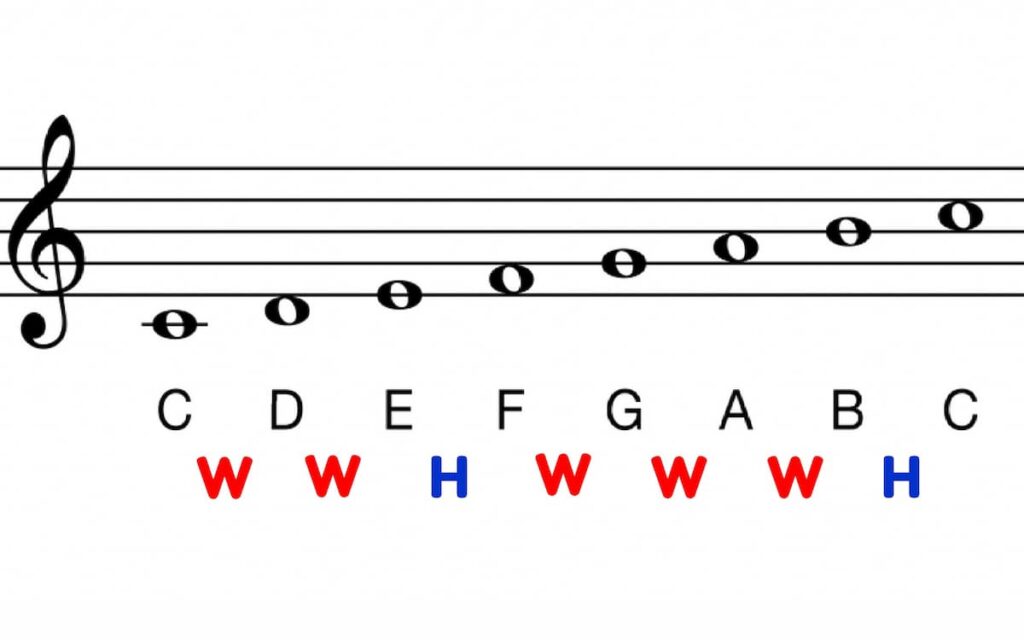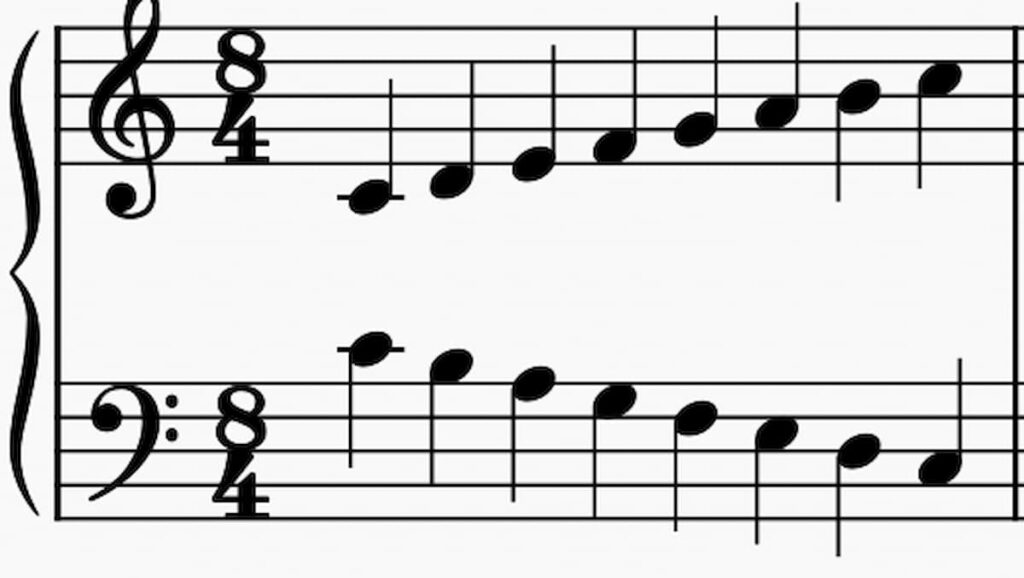As an Amazon Associate I earn from qualifying purchases.
The C major scale consists of 7 notes: C, D, E, F, G, A, B. It spans just an octave and concludes with the next C on the keyboard but can continue further than that in either direction. The beauty of this scale is that it contains no sharps or flats and is all white keys. The major key signature is empty.
This makes it very approachable for beginner piano players.
How The C Major Scale Is Constructed
The scale construction follows a specific pattern of whole and half steps. These represent the distances between the pitches. That’s the major difference between major and minor scales.
For a major pattern, this would be whole, whole, half whole, whole, whole, half.
To make this a bit easier to see, check out the illustration of the half and whole steps for the C major scale:
Want to Learn Piano?Click Here

These steps occur between each key. So, for example, between C and D is a whole step. From D to E is another whole step, and then we have our first occurrence of the half step between E and F.
Here’s another illustration of the C major scale, but on the piano keys themselves:

As you can see, half steps are only a distance of one key away. The whole steps, however, are the distance of two piano keys away. I always recommend beginner pianists use both visuals to better understand how these patterns work. Not only knowing the musical notes of the staff but also how they look at the keyboard itself.
No matter what scale you’re learning, it will follow this exact same pattern if it’s in the major mode. C major is the easiest one to follow because there are no black keys for this scale.
Scale Degrees
Another way to remember what notes are in the C major scale is to use scale degrees. Scale degrees are numbers given to notes of a scale within a given key. These number values are assigned to each step in the musical scale, beginning with number 1 and ending with 7.
Because the C major scale only has seven different notes, there is no need to use the number eight. Otherwise, that could get confusing because it’s also C.
Below are the scale degree names:
- 1 – Tonic
- 2 – Supertonic
- 3 – Mediant
- 4 – Subdominant
- 5 – Dominant
- 6 – Submediant
- 7 – Leading Tone
While all of these scale degrees are important, you’ll want to pay attention to the Tonic, Dominant, and Leading Tones. The tonic is the first note of the scale, so in our case, C. This is where the scale starts.
The dominant is the fifth note of the scale or G. This is where many harmonies and contrasts are formed in music, so it’s an important note to be aware of. Also, this note is part of your tonic triad (CEG) when you make a chord.
Then, of course, the leading tone, B. Without the correct leading tone being a half step away from the tonic, it wouldn’t function correctly and be bothersome to our ears.
Playing C Major Scales At The Piano – Fingering And Approach
Now that you understand how the C major scale works and how major scales are constructed in general, it’s time to get to put it into action.
To simplify, we’ll start one hand at a time, explaining the fingering pattern for C major scales and some techniques to consider when executing it.
For reference, here is a chart of the hands with finger numbers attached so you can know what the association is:
Just remember, for both hands, the thumb is always 1, followed by finger 2 (index finger), finger 3 (middle finger), finger 4 (ring finger), and finger 5 (the pinky).
Right Hand C Major Scale Fingering
The right-hand fingering for a one-octave C major scale is 1,2,3,1,2,3,4,5. The C major fingering chart below furthering illustrates this:

When playing this scale in the right hand, it’s important to cross under your third finger with your thumb. The cross-under should be done without an awkward wrist twist. Rather, you should come up slightly and keep a parallel angle with the keyboard.
Turning too much can cause your scale to sound bumpy, lose sound quality, and mishits.
On the descent, the scale fingering will be the above fingering but backward. So, in this case, 5,4,3,2,1,3,2,1. Instead of a cross-under, your hands will perform a cross-over with finger number 3. Keep this fingering in mind because you’ll see it come up again as we discuss the left hand next.
Left Hand Fingering For C Major Scale
The fingering for the left hand is much like the right hand but inverted.
The left-hand fingering for a one-octave C major scale is 5,4,3,2,1,3,2,1. The C major fingering chart below furthering illustrates this:

Right away, you probably notice that there is no cross under as you ascend the scale. Because the left hand is a mirror image of the right hand, it’ll do a cross-over instead. You’ll play the first five fingers and then come across with finger 3 until you get to the top of the scale.
The descent is simply taking the scale backward. What’s unique about this is that the pattern down is the same finger numbers as the right-hand C major scale’s ascent. So, it’ll feature the cross under of the thumb once you get to finger number 3, and then you can conclude with the pinky on the final C.
Other Ways To Practice The C Major Scale
It may be helpful to practice scales with the hands apart at first, but that’s not how we see it in piano music. We’re often responsible for putting them together, sometimes as a whole, sometimes in partial scales.
Over the years of working with students, I have discovered some really helpful ways to do this without making things seem too daunting. See some of my practice tips below for the C Major Scale.
Using Contrary Motion
When people think of playing scales together, their mind goes into parallel motion. This means playing the scale in both hands, going up at the same time and down simultaneously.
The issue with parallel motion, especially for a new pianist, is that the hands are backward/mirror images of one another. This means the crossovers and crossunders will occur at different times.
That is too confusing at first, and it’ll surely cause many mistakes and discourage a beginner.
This doesn’t mean you can’t put this musical scale together early in your piano studies. So, I suggest contrary motion scales. Here’s how it works:

As you can see from the diagram, the thumbs both start on the same C. Then you play your scales going the opposite directions from one another. When you do it this way, you will notice your hands are using the exact same fingering and performing their crossovers and crossunders at the same time. It’s a neat way to get the hands playing together.
Once you’ve mastered contrary motion scales, it’s time to move on to parallel motion.
Parallel Motion Scale
To truly master any scale, you’ve got to be able to put them into parallel motion. I find it helpful to play the scale in “windows.” This means that anytime I get to a point where a cross-over or cross-under has to happen, I pause on that note and look at my hands. I also say the word “switch” and confirm my hands are doing the right thing!
For example, on the ascent, the right hand will play with different fingers than the left hand. However, when the left-hand turns to the switch, they’ll be playing finger 3. Seeing and feeling those in slow practice is important, and then building on the scale.
Formula Patterns
Formula patterns may seem like a complex piano scale at first; however, it’s attainable with knowledge of how contrary scales work. I recommend starting this scale once you’re comfortable playing one-octave parallel motion scales.
The pattern is as follows: Up, out, in, up, down, out, in, down
The hands will start by going up in parallel motion for one octave; then, it will feature the contrary motion scale going out and in, followed by another up parallel scale.
The next half of the scale is the same, but with a down parallel motion to start and end it.
The Takeaway
When it comes to piano scales, the C major scale is the easiest one to start with. It has a simple finger pattern and features no sharps or flats, unlike other key signatures. It also shares the same simplicity as the A natural minor scale (another great one to start with).
Hello & thanks for stopping by! I’m a professional concert pianist and piano instructor. In the United States, I’ve given successful performances in several places including New York, Florida, Connecticut, & New Jersey, I have also performed internationally in Italy and made my Carnegie Hall debut in 2014. I enjoy blogging about the piano, the art of performance, general music, current events and the latest in music production.
